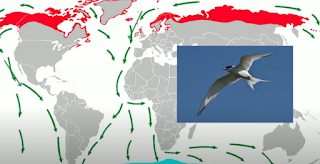Animal migration is the periodic journey of an animal from one place to another and then back again. There are many examples of animals that migrate. Geese are one example. Geese migrate in search of favorable weather, a place to breed, and a food supply. In just 24 hours, these birds can travel 2,214 kilometers from Canada to the southern U.S. or vice versa.
The Grants Caribou is another example of an animal with a long migration journey. These animals travel almost 4000 km in order to reach their calving grounds and find food sources that satisfy their vegetarian lifestyle.
The Arctic Tern will fly more than 17,000 kilometers between their summer home in the Arctic Circle and their winter residence near the South Pole.
Other animals like zooplankton migrate over short distances. During the day, zooplankton migrates to deep dark waters to hide from predators. When the sun starts to set, zooplankton rises back to the surface to eat under the protection of darkness.
Why do animals migrate?
There are several reasons.
Animals may migrate in order to avoid cold temperatures. Geese are an example of animals who migrate south in the winter in search of warmer temperatures.
Animals may migrate in order to find food. The Grants Caribou’s diet consists of specific plants such as willows, sedges, and lichens. Caribou must travel continuously to find adequate food. The bar-headed goose migrates over the Himalayas to spend the winter in parts of South Asia where it feeds on barley, rice and wheat.
Animals may migrate to an area that provides a more favorable environment for reproduction. Two fish species serve as examples of animals that migrate for reproductive reasons: the salmon and the alewife. Salmon migrate each year to their home rivers and streams to reproduce. Salmon must travel upstream and often have to make impressive leaps over rapids and low waterfalls to reach their breeding grounds. These fish have the ability to jump nearly 12 feet in the air! Though alewives spend most of their lives at sea, they will migrate back to freshwater during the spring to spawn. Female alewives can lay up to 300,000 eggs!
Annually, mass migration events occur in the Serengeti. 1.7 million wildebeest and hundreds of thousands of large game animals such as gazelles and zebras follow circular patterns of movement looking for new and more abundant food sources.
So maybe, the next time you get an urge to go on a road trip or a long walk, it may be your inner compass telling you it is time to migrate.
Related Links






0 comments:
Post a Comment